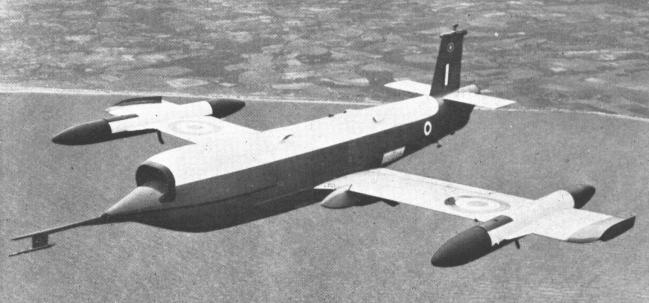GAF Jindivik (original) (raw)
The Jindivik is an Australian aerial target drone, which has seen widespread use in Australia and the UK for 50 years. It is included in the Directory of U.S. Military Rockets and Missiles, because a few examples were briefly used by the U.S. Navy.
Development of the Jindivik began at the Government Aircraft Factories (GAF) in Australia in 1948. A piloted test prototype, named Pika, flew in October 1950, and the first unmanned Jindivik Mk.1 flew in August 1952. It was powered by a single Armstrong Siddeley Adder ASA.1 turbojet. Only 14 Mk.1s were built before production switched in 1953 to the Mk.2 with a Bristol Siddeley Viper ASV.3 engine. The Mk.2 was known as Mk.102 in UK service. A total of 190 Mk.2 series Jindiviks were built, including three Mk.2A prototypes with extended wings and modified intake and 76 Mk.2Bs (Mk.102B in UK) with the Viper ASV.8 engine. The first flight of the Mk.3 variant, with higher performance, upgraded equipment and more versatile mission options, occurred in May 1961. The few Mk.3 drones were followed by a large production run of almost 150 Mk.3As (Mk.103A in UK and Mk.203A in the Royal Australian Navy). Beginning in 1964/65, 42 Mk.3As were delivered to the U.S. Navy. The USN Jindiviks were designated as Mk.303A, but were most probably identical to the standard Mk.3A/103A. They received neither USN serial numbers nor a standard U.S. military target drone designation.
 |
|---|
| Photo: via Jane's |
| Jindivik Mk.103A (with extended wings) |
The Jindivik Mk.3A was powered by a Bristol Siddeley Viper Mk.201 (model ASV.11) turbojet. It was runway-launched on a remotely controlled take-off trolley and was recovered with a landing on a retractable central skid. The drone was radio-controlled either from a ground station or from an accompanying director aircraft. Jindivik was used for tests of surface-to-air and air-to-air guided missiles. For this purpose, it could be equipped with transponders for radar-tracking at greater range, radar reflectors, heat sources for enhanced IR signature and towed targets. Wide-angle cameras could be installed in the wingtip pods to record the approach trajectory and the miss distance of the attacking missiles. One distinguishing feature of the_Jindivik_ Mk.3 series was the option to use wings of different span by installing optional wingtip extensions. That way the target could trade top speed for altitude/duration, and vice versa.
Unfortunately, I couldn't find any details about the U.S. Navy service career of the Jindivik Mk.303A. In any case, the Jindivik didn't last long in U.S. service, as it had ceased operations by the end of 1968. At least 14 of the Mk.303As were subsequently transferred to the UK.
The later variants of Jindivik were not used by the U.S. military, and detailed descriptions are therefore outside the scope of this article. The Mk.3A series was followed by 126 Mk.3Bs (Mk.103B in UK, Mk.203B in RAN service), which were modified to be better suited for low-level high-speed operations. The final Jindivik variant was the Mk.4A, which was built exclusively for the UK (and known there as Mk.104A). Beginning in March 1981, 33 Mk.4As were delivered. In 1987, the GAF became the Aerospace Technologies of Australia Pty Ltd company. A total of over 500 Jindiviks of all versions have been built, and the drone was still in use in the early 2000s.
Specifications
Note: Data given by several sources show slight variations. Figures given below may therefore be inaccurate!
Data for Jindivik Mk.3A:
| Length | 8.76 m (28 ft 8.75 in) |
|---|---|
| Wingspan | standard: 5.87 m (19 ft 3.2 in)with extensions: 7.80 m (25 ft 7.2 in) |
| Height | 2.08 m (6 ft 9.85 in) |
| Weight | empty: 1300 kg (2900 lb); max: 1600 kg (3600 lb) |
| Speed | 904 km/h (564 mph) |
| Ceiling | standard span: 18900 m (62000 ft)extended span: 20100 m (66000 ft) |
| Range | 1320 km (820 miles) |
| Propulsion | Bristol Siddeley Viper Mk.201 turbojet; 11.1 kN (2500 lb) |
Main Sources
[1] John W.R. Taylor (ed.): "Jane's All the World's Aircraft 1966-67", Jane's, 1967
[2] Kenneth Munson: "World Unmanned Aircraft", Jane's, 1988
[3] Kenneth Munson (ed.): "Jane's Unmanned Aerial Vehicles and Targets, Issue 15", Jane's, 2000
Back to Directory of U.S. Military Rockets and Missiles, Appendix 4
Last Updated: 16 June 2004